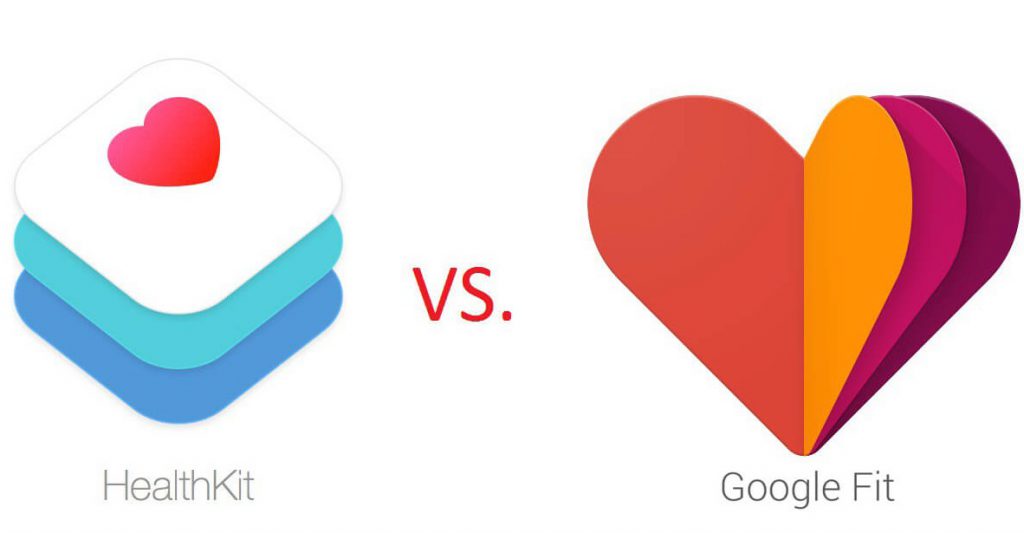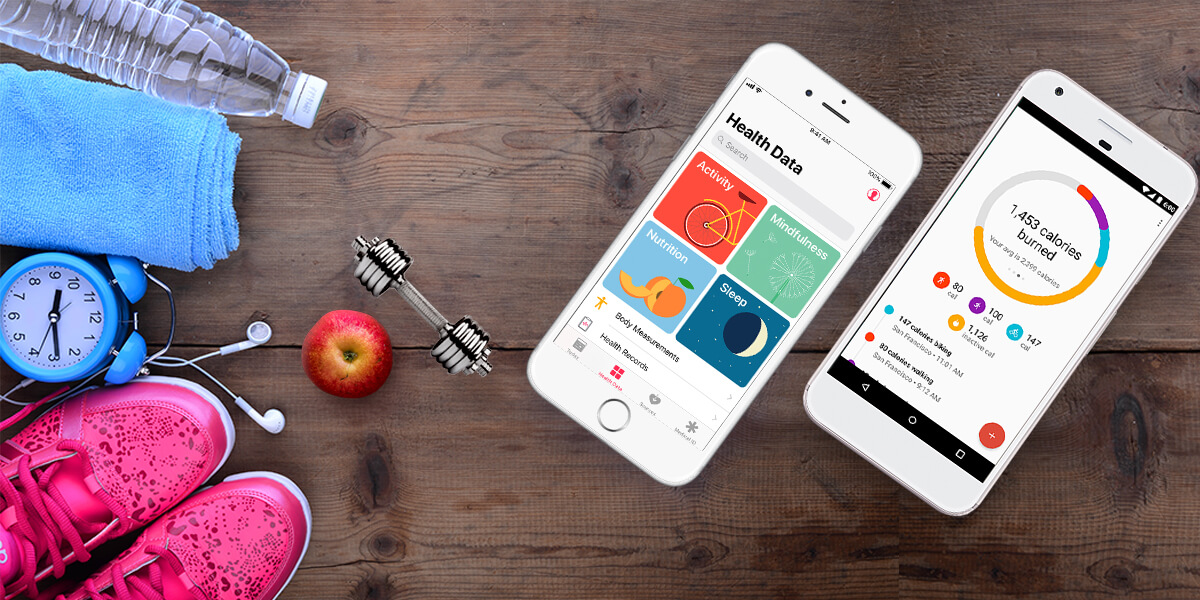How Can HealthKit and Google Fit be Used for Healthcare and Fitness App Development?
- Mobile
- March 21, 2018
As people are growing more conscious about maintaining their health and fitness, more numbers of health apps are getting downloaded both from Google Play Store and Apple App Store. Google and Apple have locked horns on various occasions and today their two of the most popular healthcare platforms HealthKit and Google Fit will come to the center stage to take this competition further.
Apple had introduced HealthKit during the launch of iOS 8, whereas, Google Fit was released near about four years ago in October 2014. However, before we can go into the details, let’s share a few statistics to indicate how the demand of health and fitness apps have augmented. According to a research by Accenture, the global health market is expected to grow up to $37 billion by this year in 2018.
Both Google and Apple are prepared to serve their users with two advanced platforms. However, there is the difference between the two. So, first have a glance at Google Fit followed by HealthKit.

Google Fit
Google Fit is the health platform launched by Google, which primarily makes use of your Smartphone’s sensors to monitor various activities such as jogging, running, walking, swimming and cycling automatically.
It is more than a useful health tracking platform allowing the users to track their fitness goals such as weight reduction, burning of the calories etc. You can monitor the results of each day, week or month. You can download it from Google Play Store for free, however, if you have an Android Smartwatch, then it will already be inbuilt there.
Apple HealthKit
HealthKit was initially announced by Apple Inc. at the Worldwide Developers Conference (WWDC) 2014 and released with the launch of iOS 8. It is also a healthcare platform, which basically collects and records from the different health and fitness apps so that it becomes accessible to the end users.
The HealthKit has been developed in such a way that it establishes a connection between two health apps (heart monitoring and diabetes track) to work together to send the data to one another for optimal patient care.
This data is direct, can be sent to the doctors directly through another app so that doctor can check the progress of health. The data can be accessed remotely.
But here lies the major difference between the two platforms. While Google Fit is mainly concentrating on tracking the health activities, Apple’s HealthKit focuses on monitoring the medical parameters such as tracking the cardiac-related activities, keeping an eye on the blood pressure level.
Healthcare and Fitness App Development Using HealthKit and Google Fit
Now let’s know some details how you can actually develop a health and fitness app with the help of these two vital healthcare platforms. It can be discussed under various parameters wherein one would also analyze the key differences in their approach.
1. App Designing
When we take a peep at the designing of Google Fit, we can see a simple and user-friendly design that draws the attention. But the drawback is that every time the user wants to avail any information he has to swipe the screen.
In addition, if you do not wish to work out along with phone, you can use the option of Add Activity from the menu button. This allows you to choose the activity you prefer. You can know the previous day’s data, a week or month on both apps as well as website.
It also provides the graph details and you can even add another chart for monitoring your weight and heart rate.
The HealthKit is just worth its name and it offers the same details as Google Fit. But it is somewhat more complex as compared to other health and fitness apps. However, the users can easily monitor all the available data on one screen only comparing them to get the results of the health report card.
Based on the outcome they can decide whether it is the right time to consult the doctor. You also get other useful insights such as information on food and alcohol intake, monitor sleep patterns etc.
You can also keep a watch on other important factors like measuring your body height and weight and decide what strategy to adapt to remain fit. It also maintains the data of your medical record as well.
2. Some of the Esteemed Partners or Clients
If you are planning to develop fitness app with either of these two arch competitors, then you must take a note of which brand is associated with which healthcare platform. To speak off Google Fit, it prides itself to have on the board partners like Adidas, HTC, and Asus etc. and is constantly on the hunt for the new ones.
On the other hand, HealthKit is having Nike and Fitbit as its valued clients and it has also teamed up with Mayo Clinic, the leading healthcare organization in the United States. It is also adding more partners on that list.
3. The Privacy and Security Features
Data Privacy and Security wise, HealthKit is a better option. You know that iOS has always excelled Google in security matters. The Google Fit has certain limitations; for instance, Google Fit is just a health and fitness tracking app; it does not offer you any help on monitoring the medical parameters. You are also not allowed to use this platform along with any other medical device under the Section 201(h) of the Federal Food Drug & Cosmetic (FD&C) Act.
The HealthKit has much better security features and it can only be operated on the latest versions of the iPhones. The advanced models have fingerprint sensors to identify the user and since the data collected in HealthKit is mainly medical records, it is stored in a highly protected place with a number of backups. It also follows the strict guidelines of Food and Drug Administration (FDA) of USA.
Read also: Health and Fitness App Development: Must Have Features and Cost Estimation
4. Type of Data Recorded in Both
Well, both the popular healthcare platforms record and store data for the information of the user and monitor their progress in health. They are usually categorized into two main categories:
- Fitness Related Data, which is manually added
- Medical Data
If we talk about Google Fit, then it provides you useful input on various fitness constraints such as measurement of the body in terms of height and weight, reduction of calorie for losing fat and weight, distance covered during walking or cycling, count of heartbeat and time consumed in workout etc.
On the other hand, HealthKit also provides vital data information on heart rate, amount of calorie burnt, the number of steps covered and vital info on sleep pattern.
The Google Fit does not have any major contribution in the medical app recording. The only record that you get here is calculating the heart rate.
However, this is the point where HealthKit wins the battle. Yes, you get all the data related to medical records such as blood pressure, the sugar level in body, presence of cholesterol in heart. Therefore, it is also rendered helpful for the doctors as well.
In addition, it also provides you pivotal information on the lab test reports, important medications and precautions, keeping a balanced nutritional level by following a well-balanced diet chart including several others.
Read also: How Mobile Health Apps Proving to be a Boon for the Patients
Conclusion
So, we had a fair comparison between the two most leading healthcare platforms and both offer their own advantages. However, Apple’s HealthKit excelled its competitor Google Fit on various occasions such as providing better security and providing the facility of recording the medical data.
On the whole, both track the fitness activities and also monitor the heart rate. Now it is up to you, which healthcare platform you want to personally choose. If you want medical information with fitness, then HealthKit is your key and if you only are concerned about only fitness, then Google Fit will suit your requirements.














